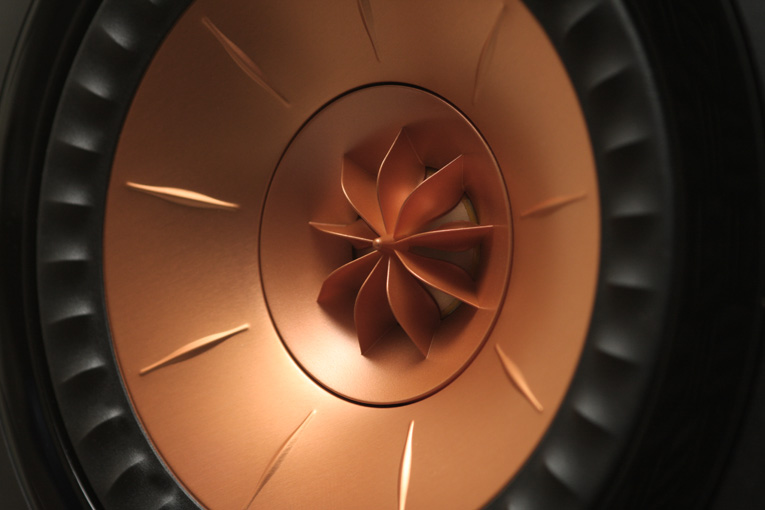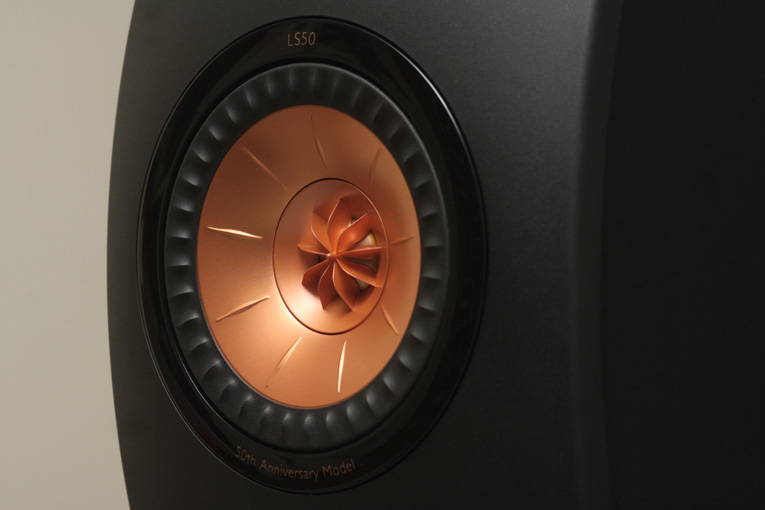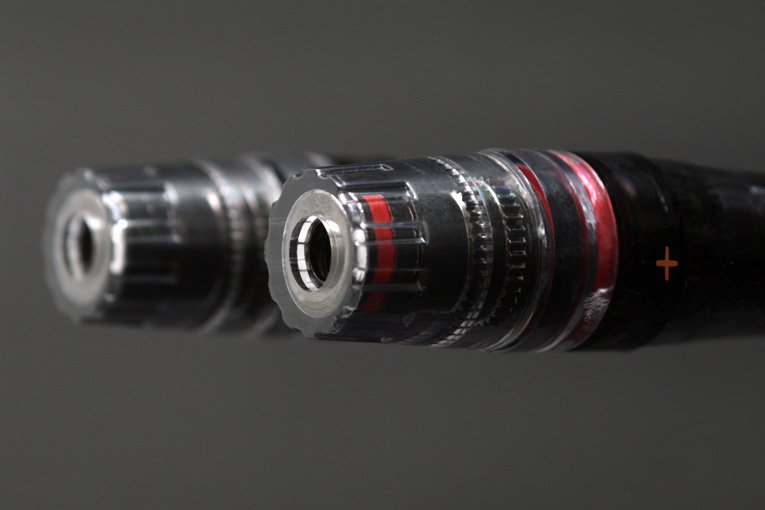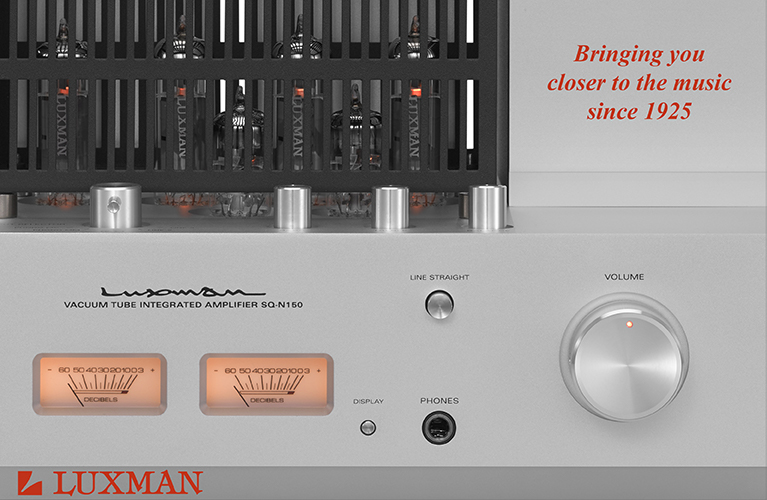Note: Measurements taken in the anechoic chamber at Canada's National Research Council can be found through this link.

 When I turned 30, I thought I was getting old, but everyone kept telling me, “Oh, you’re still young.” They were right -- no one at that age is really old. When I turned 40, fewer people told me I was still young, which made me wonder. Now, as I approach 50, no one’s telling me I’m young, not even my mom; instead, it’s more like, “Really? You’re that old?” If that’s not a hint that I’m no longer improving with age, nothing is.
When I turned 30, I thought I was getting old, but everyone kept telling me, “Oh, you’re still young.” They were right -- no one at that age is really old. When I turned 40, fewer people told me I was still young, which made me wonder. Now, as I approach 50, no one’s telling me I’m young, not even my mom; instead, it’s more like, “Really? You’re that old?” If that’s not a hint that I’m no longer improving with age, nothing is.
Unlike me, KEF actually does appear to be improving with age, even as they pass the half-century mark. The British company was founded in 1961 by the late Raymond Cooke to “pioneer the use of synthetic materials in creating superior loudspeakers.” The high-tech mentality with which, under Cooke’s leadership, KEF began has stayed with them through five decades as they released speaker after speaker that pushed the envelopes of technology and design -- even after Cooke’s death in 1995.
KEF turned 50 in 2011 and celebrated with the release of the Blade, which sells in the US for $30,000 per pair. I haven’t reviewed the Blade, but I was smitten the moment it was released, and have been impressed every time I’ve heard a pair playing at one of the many audio shows I attend around the world. From what I can tell, the Blade is one of KEF’s best efforts ever -- and technology trickled down from it has spawned a string of great new KEF speakers. Last year I reviewed the R500, part of KEF’s R series, which uses Blade-inspired drivers, and found that the R500 sounded spectacular for its price of $2599.98/pair. Since then, fellow writers Roger Kanno and Hans Wetzel have each bought R900s and use them as their references -- both feel they’d be hard-pressed to do better for $4999.98/pair.
Now comes the stand-mounted LS50, released in 2012 and, like the Blade, called a 50th Anniversary Model, and priced lower than any KEF model mentioned so far: $1499.99/pair. I wondered if it could live up to all that had come before . . .
Description
The LS50 stands alone -- it isn’t part of any of KEF’s many series of speaker models. Instead, on their website they group it with the Blade and the ultra-expensive Muon ($198,000/pair!) under the heading “Flagship Hi-Fi Speakers.” Each has been designed to stand on its own, even if it seems obvious that KEF could expand each into an entire range of models. (At the 2013 Consumer Electronics Show, I asked KEF’s international sales manager, Johan Coorg, if there will be a floorstanding model similar to the LS50; the reply came back quickly: “No.”)
But KEF does tie the LS50 to something other than the Blade-developed drivers it uses. They say that it’s been “inspired by” the BBC’s legendary LS3/5A loudspeaker, which came to life in the 1970s and which KEF had quite an influence on -- the BBC allowed many different companies to manufacture the design under license, but its drivers were all made by KEF.
The LS50 is likely the most advanced two-way to be offered at anywhere near this price, and it doesn’t need to be tied to anything else, even the legendary LS3/5A. In fact, it’s what most compact two-ways of any price want to grow up to be.

The LS50’s Uni-Q driver, which has a rose-gold color, is a direct descendant of the one they pioneered for use in the Blade -- not precisely the same, but it looks almost identical, at least from outside. In a KEF Uni-Q driver, the tweeter sits at the center of the midrange-woofer cone, which allows the entire speaker to act as a perfect point source. This speaker’s midrange-woofer measures about 5.25” (130mm) in diameter, its tweeter 1” (25mm); both are made of aluminum. They’re crossed over to each other at 2.2kHz.
That said, coincident drivers such as this aren’t unique to KEF; they were around long before KEF started messing with them and making them the cornerstones of their designs. But KEF has taken the idea many steps further than most companies have or could. For example, the shape of the midrange-woofer’s cone and its “tangerine” waveguide (KEF’s word, including quotes) are said to provide ideal dispersion for the tweeter. The tangerine waveguide also protects the tweeter, which is important -- the LS50 has no grille. The cone’s surround, which has ribs (probably to improve excursion and limit distortion), is flat and unobtrusive, which helps reduce the kind of diffraction problems caused by regular surrounds. I don’t think it would be out of line to say that, right now, KEF’s current line of Uni-Qs are the most advanced coincident drivers on the planet.
Then there’s the cabinet, which measures about 12”H x 8”W x 11”D and is made mainly of MDF, using constrained-layer damping to optimize inertness. This can’t be done by using only a single material; in the LS50, a layer of material softer than MDF is placed between the internal brace and where it connects to the walls.
The finish on the LS50’s sides, top, bottom, and rear is a high-gloss black, and the KEF logo is embedded in the finish on the top panel. It’s hard to knock the way the LS50 is built unless you want to knock where it’s built: China. But according to KEF, their factory there is better suited to building LS50s than their facility in the UK. Whatever the case, the build quality is there.

There’s more. KEF says that the matte-black front baffle, made of an “engineered polymer,” has been shaped to eliminate diffraction effects in order to achieve the smoothest wavelaunch, and is ribbed on its backside to achieve optimal rigidity. Finally, there’s the port. Though in most reviews ports are mentioned only in passing, this one deserves some attention. Its elliptical shape is as innovative as its spongy center tube; both are designed to reduce resonances and air turbulence so the escaping bass frequencies don’t produce chuffing or other untoward noises.
KEF claims for the LS50 a frequency response of 79Hz-28kHz, +/-3dB, with a -6dB point of 49Hz; a sensitivity of 85dB/2.83V/m; and a nominal impedance of 8 ohms (with a 3.2-ohm minimum). They also claim second- and third-harmonic distortion of less than 0.4%, 175Hz-20kHz (90dB/m), and maximum output of 106dB. The latter is really loud, though no measuring distance or frequency range is given for this spec, so it tells you only so much. Impressive specs, overall, but the real test is in the listening . . .
Sound
I placed the LS50s on my 24”-high Foundation stands, which I at first feared might be a little low; but the LS50s dispersed sound so evenly -- the greatest benefit of Uni-Q drivers -- that the Foundations worked fine. I hooked up the KEFs to Simaudio’s ultra-heavy (100 pounds), super-powerful (300Wpc into 8 ohms), very expensive ($20,000) Moon Evolution 870A stereo amplifier, simply because that’s what was closest to them at the time, and played “Real Real Gone,” from Van Morrison’s Enlightenment (16-bit/44.1kHz FLAC, Polydor).
My eyes opened wide, my mouth fell open, and my hands were immediately drawn to the speaker cables, to hook up the LS50s to a far less powerful, lower-cost amp: the Eximus S1 (125Wpc into 8 ohms, $2500). I wanted to find out if the unbelievably full, rich sound I was hearing had mostly to do with the Simaudio amp, or if I could replicate it with something that a $1500/pair minimonitor might actually be used with in the real world. Moments later, I had the answer: I could.
Then, for the heck of it, I tried the LS50s with the Copland CTA 506 ($6000), a tubed stereo amp that puts out 90Wpc into 16, 8, or 4 ohms; as well as a pair of Anthem Statement M1 monos ($3500 apiece), a proprietary class-D design capable of unbelievably high power (1000W into 8 ohms). The sound was slightly different with each amp, but one thing remained the same: the diminutive LS50s sounded much bigger than their size let on. I also learned that, with any of these amps, the LS50s could play loud -- louder than I expected from speakers of their size, and louder than I really needed them to.

Part of their big sound had to do with how the LS50 projected soundwaves unencumbered by their cabinets, to lay out an enormous soundstage with recording after recording. They “disappeared” completely into those vast soundstages, giving no aural hint of their actual physical locations. The fine 24/176.4 recording of Cat Stevens’s 1970 classic Tea for the Tillerman, which HDtracks offers for download, was rendered with excellent soundstage spreads from left to right and from front to back. What floored me wasn’t only the scope of that stage, but the specificity within it -- musicians popped up almost holographically in their correct spaces, with real presence. I was also particularly taken with the rendering of my ol’ imaging-and-soundstaging standby, “Everest,” from Ani DiFranco’s Up Up Up Up Up Up (16/44.1, Righteous Babe), in which her voice distinctly appears in the left of the soundstage. Not only was DiFranco’s voice placed precisely where it should be -- just inside of the left speaker and a couple feet back from the baffle -- her voice had real tangibility, along with some ambience around it that I hadn’t noticed before. Minimonitors are often praised for reproducing imaging superior to that of larger speakers; the KEF LS50s took this a step further than most.
Another part of the LS50’s big sound had to do with its bass, which was far fuller, deeper, and richer than I thought could ever be mustered from a 5.25” driver in a 1’-tall box. Granted, that bass wasn’t as visceral or as taut as I’ve heard from larger, more costly two-ways, such as the Music Culture RL21 ($3499/pair), which I reviewed last month -- the ballsy drumming that opens “Rolling in the Deep,” from Adele’s 21 (16/44.1 FLAC, XL), sounded slightly woolly through the LS50s -- but high fives to KEF’s engineers for being able reach below 50Hz with a shocking amount of weight and impact while retaining half-decent sensitivity (they specify 85dB; our own measurements show 84.25dB, which isn’t all that far off). I guess that’s what you get when you employ some of the best engineers in the business to figure these things out.
But what made the LS50 sound downright spectacular was its exceptional voicing throughout the audioband. It made this big-sounding little speaker sound so natural and real that I’m pretty sure it could give a number of much costlier speakers, stand-mounted and floorstanding, grief.
Buena Vista Social Club Presents Omara Portuondo (16/44.1 FLAC, Nonesuch) exploded into my room with a stage that went from here to there, and Portuondo’s voice was placed in the center of it in an extraordinarily lifelike way: tonally accurate, vividly positioned, richly textured, totally tangible, and completely authentic. Leonard Cohen’s thick, rich voice in “Amen,” from his most recent release, Old Ideas (16/44.1 FLAC, Columbia), was rendered with the same combination of fullness and detail that I heard through the R500s, a speaker I praised for its outstanding midrange performance, which I felt could easily be compared with those of speakers costing multiples of its price -- which means that what the LS50 offers for its price borders on the revelatory.
The LS50’s highest frequencies sounded as if they’d been deliberately tipped up to add air and expansiveness. But violinist Vanessa-Mae’s The Original Four Seasons and the Devil’s Trill Sonata (16/44.1 FLAC, Angel), a strident-sounding recording, let me know that the LS50’s highs weren’t tipped up enough to cause it to sound objectionably bright -- any stridency I heard was inherent in the recording, not exacerbated by the tweeter. Instead, the way the LS50s’ tweeters soared through the highest frequencies of Vanessa-Mae’s recording, and of Ennio Morricone’s choral and orchestral score for the film The Mission (16/44.1 FLAC, Virgin), was on a par with what I’d heard from the R500 -- which I praised for sounding “clean, extended, and refined.”
The LS50s’ re-creation of piano was shocking -- many large speakers have trouble doing this in a way that sounds wholly natural, and most small ones don’t stand a chance -- they often sound tinkly, like a child’s toy piano. The LS50s made Ola Gjeillo’s piano-based Stone Rose (16/44.1 FLAC, 2L) sound thundering and glorious in a way I thought no small speaker could ever. And if I had to describe in a single word the LS50s’ reproduction of Norika Ogawa’s recording of Mozart’s Piano Sonatas 10-12 (24/96 FLAC, BIS/eClassical.com), that word would be pure. Every keystroke was presented with a crystalline clarity that wasn’t only uncanny for the LS50s’ price, but for multiples of it. KEF makes some noise about creating low-distortion drivers and is one of only a few manufacturers to publish distortion figures for its speakers, which our own measurements have revealed to be accurate. My thinking is that the LS50’s and R500’s low distortion from the lower midrange through the highs contributed to the amazing clarity both speakers exhibited in my system.

If I sound over the moon, I am. But the LS50 wasn’t perfect. The bass, while amazingly full, sacrificed tautness for depth. Speaker design is a balance of tradeoffs, and I can only suspect that the KEF engineers deliberately chose depth over tautness because they had to. That this was a deliberate design choice is reinforced by the fact that I made the same criticism of the R500. But they probably made the right choice for the LS50 -- despite the speaker’s other great qualities, it wouldn’t be nearly as impressive if it sounded light or thin, no matter how taut its bass. Ditto the R500.
Nor was the LS50 strictly neutral. The emphasis in the bass, that distinctive midrange sound that helps voices and instruments sound palpable and real, and in the highs, which to my ears seemed just a touch tipped up, pointed to a little bit of “voicing” going on -- skillful voicing. This was corroborated when we measured the speaker. When the entire frequency-response trend is looked at, it is fairly flat from on and off axis, but it’s not ruler flat. However, such deviations from neutrality aren’t something I’ll hold against the designers. Whatever they’ve done has resulted in the LS50 being one of the best-sounding small speakers I’ve ever heard. I can’t quibble with that.
The only real flaw I could find was this: The LS50 could play impressively loud, but when pushed too hard, the lower midrange sounded a touch chesty and resonant. This made male voices and the low end of acoustic pianos sound a bit less clear when the LS50 was played outside of its comfort zone. Given everything else the LS50 did right, and the facts that it’s a small speaker, costs only $1500/pair, and is likely to be used in rooms of small to medium size . . . it’s no big concern.
Conclusions
When I reviewed KEF’s R500, I said that it “sets a new standard for what can be expected at this price.” Insofar as small floorstanders go, that’s still true. Now, I can say pretty much the same about what the LS50 does in the world of minimonitors -- and a little more. The fact that KEF has positioned this model as a one-off design in the same category of “Flagship Hi-Fi Speakers” as its very expensive Blade and ultra-expensive Muon models serves only to heighten its appeal -- combined with its fine build quality and distinctive styling, the LS50 comes off as more a luxury item than a mass-market two-way, even if it is made in the Far East. You can’t say that about many speakers, even the R500. The LS50’s sound, irrespective of price, was outstanding in my room: a wide-open soundfield; razor-sharp imaging; voluminous bass; soaring, clean highs; and a midband as natural as it was clear. Holy moly, this speaker sounded good -- and at a ridiculously low price.
The LS50 is nothing short of a masterpiece of a minimonitor, priced so that anyone serious about audio can buy a pair -- and probably should, if only to know how great a small speaker can be. Time hasn’t been as much on my side as it’s been on KEF’s -- the LS50 is one of their best speakers yet, and one of their best values; it’s proof that, as it ages, this company seems to get better and better.
. . . Doug Schneider
das@soundstagenetwork.com
Associated Equipment
- Loudspeakers -- Music Culture RL21, KEF R500
- Amplifiers -- Eximus S1, Simaudio Moon Evolution 870A, Copland CTA 506, Anthem Statement M1s (mono)
- Preamplifiers -- JE Audio VL10.1, Simaudio Moon Evolution 740P
- Digital-to-analog converters -- Ayre Acoustics QB-9, Meitner Audio MA-1
- Computer -- Sony Vaio laptop running Windows Vista and JRiver Media Center 17
- Digital interconnect -- AudioQuest Carbon
- Analog interconnects -- Nordost Valhalla
- Speaker cables -- Nirvana S-L
KEF LS50 Loudspeakers
Price: $1499.99 USD per pair.
Warranty: Five years parts and labor.
KEF
Eccleston Road, Tovil, Maidstone
Kent, England ME15 6QP
UK
Phone: +44 (0)1622-672261
Fax: +44 (0)1622-750653
Website: www.kef.com
North America:
KEF America / KEF Canada, Inc.
10 Timber Lane
Marlboro, NJ 07746
Phone: (732) 683-2356
E-mail: sales@kefamerica.com






















